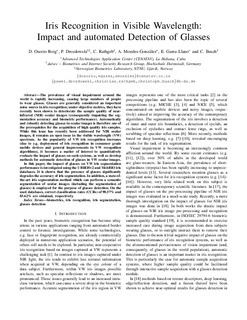| dc.contributor.author | Osorio-Roig, Daile | |
| dc.contributor.author | Drozdowski, Pawel | |
| dc.contributor.author | Rathgeb, Christian | |
| dc.contributor.author | Morales-González, Annette | |
| dc.contributor.author | Garea-Llano, Eduardo | |
| dc.contributor.author | Busch, Christoph | |
| dc.date.accessioned | 2019-05-22T10:37:28Z | |
| dc.date.available | 2019-05-22T10:37:28Z | |
| dc.date.created | 2019-05-09T12:59:22Z | |
| dc.date.issued | 2018 | |
| dc.identifier.isbn | 978-1-5386-9385-8 | |
| dc.identifier.uri | http://hdl.handle.net/11250/2598437 | |
| dc.description.abstract | The prevalence of visual impairment around the world is rapidly increasing, causing large numbers of people to wear glasses. Glasses are generally considered an important noise source in iris recognition; under objective metrics, they have recently been shown to deteriorate the sample quality of near-infrared (NIR) ocular images (consequently impairing the segmentation accuracy and biometric performance). Automatically and robustly detecting glasses in ocular images is therefore one of the prerequisites for the acquisition of high quality iris samples. While this issue has recently been addressed for NIR ocular images, it remains an open issue in the visible wavelength (VW) spectrum. As the popularity of VW iris recognition increases (due to e.g. deployment of iris recognition in consumer grade mobile devices and general improvements in VW recognition algorithms), it becomes a matter of interest to quantitatively evaluate the impact of glasses on such systems, as well as develop methods for automatic detection of glasses in VW ocular images. In this paper, the impact of glasses on VW iris segmentation performance is investigated using the UBIRISv2 and MobBIO iris databases. It is shown that the presence of glasses significantly degrades the accuracy of iris segmentation. In addition, a state-of-the-art iris segmentation method which can perform a semantic segmentation of ocular images (including the segmentation of glasses) is employed for the purpose of glasses detection. On the used databases, correct classification rates (CCRs) of 98.57% and 83.62% are obtained, respectively. | nb_NO |
| dc.description.abstract | Iris Recognition in Visible Wavelength: Impact and automated Detection of Glasses | nb_NO |
| dc.language.iso | eng | nb_NO |
| dc.publisher | Institute of Electrical and Electronics Engineers (IEEE) | nb_NO |
| dc.relation.ispartof | The 14th International Conference on Signal Image Technology & Internet Based Systems (SITIS) | |
| dc.title | Iris Recognition in Visible Wavelength: Impact and automated Detection of Glasses | nb_NO |
| dc.type | Chapter | nb_NO |
| dc.description.version | acceptedVersion | nb_NO |
| dc.source.pagenumber | 542-546 | nb_NO |
| dc.identifier.doi | 10.1109/SITIS.2018.00088 | |
| dc.identifier.cristin | 1696627 | |
| dc.description.localcode | © 2018 IEEE. Personal use of this material is permitted. Permission from IEEE must be obtained for all other uses, in any current or future media, including reprinting/republishing this material for advertising or promotional purposes, creating new collective works, for resale or redistribution to servers or lists, or reuse of any copyrighted component of this work in other works. | nb_NO |
| cristin.unitcode | 194,63,30,0 | |
| cristin.unitname | Institutt for informasjonssikkerhet og kommunikasjonsteknologi | |
| cristin.ispublished | true | |
| cristin.fulltext | postprint | |
| cristin.qualitycode | 1 | |
